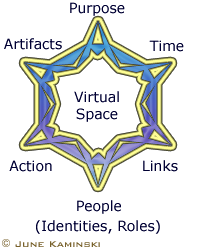
Online Collaboration, Networks & Communities of Practice
Overview

“Collaborative computing and research fosters productivity by allowing individuals at
dispersed sites to share ideas and information in real time. Collaborative computing
may use e-mail, desktop video-conferencing, other telecommunications tools, or
shared databases to join persons of like interests together.”
(Hebda, Czar & Mascara, 1998, p. 283).
 Professionals and researchers in many fields are beginning to tap the enormous potential of the Internet and other computer applications for collaborating with peers from all parts of the globe. The surge in technology breakthroughs creates a cyber-milieu only dreamed of a few short years ago. Whether engaged in education, practice, research or leadership - nurses can utilize the capability of modern computers to enrich their work, learn and share, and to work on projects
with colleagues both near and far. Professionals and researchers in many fields are beginning to tap the enormous potential of the Internet and other computer applications for collaborating with peers from all parts of the globe. The surge in technology breakthroughs creates a cyber-milieu only dreamed of a few short years ago. Whether engaged in education, practice, research or leadership - nurses can utilize the capability of modern computers to enrich their work, learn and share, and to work on projects
with colleagues both near and far.
Networks within health care can manifest in several different configurations, including client focused networks such as in telenursing, e-health, and client support networks; work related networks including virtual work and virtual social networks; and learning and research networks as in communities of practice. These trends are still in their infancy in most nursing work environments (and personal lives) but they are predicted to be a strong trend in the future. “As the Net generation grows in influence, the trend will be toward networks, not hierarchies, toward open collaboration rather than authority; toward consensus rather than arbitrary edict. The communication support provided by networks and information systems will also alter patterns of social interaction within a health care organization. This technology provides a medium for greater accessibility to shared information and support for rich interpersonal exchange and collaboration across departmental boundaries” (Richards, 2000, p. 10).
Virtual Social Networks
 Virtual social networks are another form of professional network that have expanded phenomenally since the advent of the Internet and other ICTs. “Electronic media do more than just expand access to vast bodies of information. They also serve as a convenient vehicle for building virtual social networks for creating shared knowledge through collaborative learning and problem solving. Cross pollination of ideas through worldwide connectivity can boost creativity synergistically in the co-construction of knowledge” (Bandura, 2002, p. 4). Basically, nursing-related virtual social networks provide a cyberspace for nurses to make contacts, share information and ideas, and build a sense of community. Virtual social networks are another form of professional network that have expanded phenomenally since the advent of the Internet and other ICTs. “Electronic media do more than just expand access to vast bodies of information. They also serve as a convenient vehicle for building virtual social networks for creating shared knowledge through collaborative learning and problem solving. Cross pollination of ideas through worldwide connectivity can boost creativity synergistically in the co-construction of knowledge” (Bandura, 2002, p. 4). Basically, nursing-related virtual social networks provide a cyberspace for nurses to make contacts, share information and ideas, and build a sense of community.
 Social technologies are used to provide a dynamic virtual environment, and often provide communicative capabilities through posting tools like blogs, forums, and wikis; email for sharing ideas on a smaller scale; collaborative areas for interaction, creating and building digital artefacts or planning projects; navigation tools for moving through the virtual network landscape; and profiles to provide a space for each member to disclose personal information with others. Nurses who have to engage in shift-work often find that virtual social networks can provide a sense of connection with other professionals that is available around the clock. Since time is often a factor in any social interchange, virtual communication often offers an alternative for practicing nurses who can access information and interchange at any time of day. With active participation, the interchanges and shared information/ideas of the network can culminate into valuable social and cultural capital, available to all members. Often, nursing virtual social networks are created for the purpose of exchanging ideas on practice issues and best practices; to become more knowledgeable about new trends, research, and innovations in health care; or to participate in advocacy, activist, and educational initiatives. Social technologies are used to provide a dynamic virtual environment, and often provide communicative capabilities through posting tools like blogs, forums, and wikis; email for sharing ideas on a smaller scale; collaborative areas for interaction, creating and building digital artefacts or planning projects; navigation tools for moving through the virtual network landscape; and profiles to provide a space for each member to disclose personal information with others. Nurses who have to engage in shift-work often find that virtual social networks can provide a sense of connection with other professionals that is available around the clock. Since time is often a factor in any social interchange, virtual communication often offers an alternative for practicing nurses who can access information and interchange at any time of day. With active participation, the interchanges and shared information/ideas of the network can culminate into valuable social and cultural capital, available to all members. Often, nursing virtual social networks are created for the purpose of exchanging ideas on practice issues and best practices; to become more knowledgeable about new trends, research, and innovations in health care; or to participate in advocacy, activist, and educational initiatives.
Communities of Practice
 Communities of Practice (COP) are another example of professional networks that can interact using ICTs including the Internet to collaborate on a variety of projects or initiatives, often for the sake of research or education (which are sometimes called Communities of Learning or learning communities). These networks can be viewed through the lens of social cognitive theory to reveal the enactment of collective agency. “People's shared belief in their combined power to achieve desired results is a key ingredient of collective agency. Perceived collective efficiency raises people's vision of what they wish to achieve, enhances motivational commitment to their missions, strengthens resilience to adversity, and enhances performance accomplishments” (Bandura, 2002, p. 3). Communities of Practice (COP) are another example of professional networks that can interact using ICTs including the Internet to collaborate on a variety of projects or initiatives, often for the sake of research or education (which are sometimes called Communities of Learning or learning communities). These networks can be viewed through the lens of social cognitive theory to reveal the enactment of collective agency. “People's shared belief in their combined power to achieve desired results is a key ingredient of collective agency. Perceived collective efficiency raises people's vision of what they wish to achieve, enhances motivational commitment to their missions, strengthens resilience to adversity, and enhances performance accomplishments” (Bandura, 2002, p. 3).
Although COPs are relatively new in nursing, the literature does support the benefits of such initiatives, by describing the value to nursing through “...the “doing” of community within the context of shared projects, obligations, and goals” (Page & Scott, 2001, p. 528). In fact, COPs are acknowledged as a prime vehicle for achieving the goal of informatics integration into nursing education. “Creative faculty development strategies that capitalize on the concept of faculty as a community of practice are required to incorporate informatics competencies into  nursing curricula” (Barton, 2005, p. 323). Although COPs are usually devoted to rather formal, critical issues and foci, there is a tendency to also encourage open, creative thinking and affective interaction within the socio-technical arena. “We develop the concept of “learning communities” to meet the need for democratic, inclusive, and on-going innovation ... We conceptualize 'learning communities” as dialogic and “playful” spaces within which members can draw creatively on their differences while constructing shared knowledge” (Page & Scott, 2001, p. 528). The virtual social space of COPs ideally invites collaborative inquiry, a sharing of learning or research goals as well as process, within a holistic, action-oriented network. nursing curricula” (Barton, 2005, p. 323). Although COPs are usually devoted to rather formal, critical issues and foci, there is a tendency to also encourage open, creative thinking and affective interaction within the socio-technical arena. “We develop the concept of “learning communities” to meet the need for democratic, inclusive, and on-going innovation ... We conceptualize 'learning communities” as dialogic and “playful” spaces within which members can draw creatively on their differences while constructing shared knowledge” (Page & Scott, 2001, p. 528). The virtual social space of COPs ideally invites collaborative inquiry, a sharing of learning or research goals as well as process, within a holistic, action-oriented network.
Wenger, McDermott and Snyder (2002) identified seven key principles for COP cultivation: design for evolution, open a dialogue between inside and outside perspectives, invite different levels of participation, develop both public and private community spaces, focus on value, combine familiarity and excitement, and create a rhythm for the community. Wenger also identified four general categories of COP, all of which fit well within nursing ideals and intents: helping communities, best-practice communities, knowledge-stewarding communities, and innovation communities. COP need to be actively created and sustained, which requires well developed relational links and abilities between the social actors, both human and technical.
Ends in View
This learning activity is intended to give the learner the opportunity to:
1. Explore the potential venues for collaboration with peers in nursing education, practice, research, and leadership activities and projects.
2. Understand the current computer applications available to facilitate online collaboration, networks, and communities of practice.
3. Engage in online collaborative activities with classmates, and peers in the cyber-community.
In Preparation
1. READ: Barton, A. (2005). Cultivating informatics competencies in a community of practice. Nursing Administration Quarterly, 29(4), 323-328.
2. READ: Kilian, J. & Pantuso, B. (n.d.) The Future of Healthcare is Social. Frog Design - FAST Company.
3. EXPLORE: 42 Best Project Management Software and Tools (2021 Update).
4. READ: iCohere. (2004). Community of Practice Design Guide. A step by step guide for creating collaborative communities of practice.
In Practice
1. Choose a computer application to practice collaborating with others in an online environment.
Possibilities include: e-mail; discussion lists; online chat rooms or internet relay chat (such as ICQ); linking through online databases; teleconferencing; online petitions; web forums.
2. Choose a relevant activity related to your course work this semester, and arrange to collaborate with peers in an online environment regarding your field of study. This could be
related to Self & Others; your Community Development Practice work; or your Nursing Research or Inquiry projects.
Aim to make the contact meaningful, so that the resultant information and dialogue adds to the quality and multidimensional scope of your chosen project.
 3. WORKSHEET: The assigned readings support the development of professional networking, collaboration, and communities of practice in ALL fields, which extends to health care and nursing. Using the Communities of Practice Design Worksheet , plan a community of practice (COP) that could evolve in your particular area of practice. Also include nursing informatics as a key component/focus of this COP. You may find the open source (free) software listed here useful for shaping your description. 3. WORKSHEET: The assigned readings support the development of professional networking, collaboration, and communities of practice in ALL fields, which extends to health care and nursing. Using the Communities of Practice Design Worksheet , plan a community of practice (COP) that could evolve in your particular area of practice. Also include nursing informatics as a key component/focus of this COP. You may find the open source (free) software listed here useful for shaping your description.
In Reflection
1. Reflect on how collaboration can help you in your future education and nursing career.
2. Imagine an error-free, user-friendly computer application that would make collaboration effortless.
What would this application be like?
References
-
- Agostinho, S., Lefoe, G. & Hedberg, J. (1997). Online collaboration for learning: A case study of a post graduate university course. AusWeb97,
http://ausweb.scu.edu.au/proceedings/agostinho/paper.html
- Barton, A. (2005). Cultivating informatics competencies in a community of practice. Nursing Admistration Quarterly, 29(4), 323-328.
- Bandura, A. (2002). Growing primacy of human agency in adaptation and change in the electronic era. European Psychologist, 7(1), 2-16.
- Hebda, T., Czar, P. & Mascara, C. (1998). Handbook of informatics for nurses and health care professionals. Menlo Park, CA: Addison-Wesley.
- iCohere. (2004). Community of Practice Design Guide. A step by step guide for creating collaborative communities of practice.
- Page, M. & Scott, A. (2001). Change agency and women's learning: New practices in community informatics. Information, Communication & Society, 4(4), 528-559.
- Richards, J. A. (2001). Nursing in a digital age. Nursing Economic$, 19(1), Jan/Feb, 6 – 12.
- Wenger, E., McDermott, R., Snyder, W. (2002). Cultivating communities of practice. Boston: Harvard Business School Press.
NEXT: Computers and Community Development ... . .
|